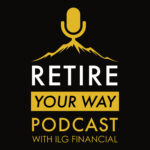 By now, everyone has heard or read about the $3.5 trillion tax and spending package being debated in Congress. The package is a part of the Biden administration’s Build Back Better agenda. Though the bill being proposed currently is only an initial proposal, it would add $3.5 trillion in new spending for the expansion of health care, family leave, climate change initiatives, and more as a part of what some have said is the biggest social welfare policy expansion bill in history. These ideas and programs all sound great, but they cost money. And with the United States being in the largest debt crisis since World War II, our taxes are what are going to have to pay for it. Funding this new bill will include an array of new and expanded taxes. More importantly, this bill highlights lots of changes to tax scenarios impacting IRAs, 401(k)s, Roth’s, and many other retirement accounts and vehicles, specifically tax-free savings vehicles.
By now, everyone has heard or read about the $3.5 trillion tax and spending package being debated in Congress. The package is a part of the Biden administration’s Build Back Better agenda. Though the bill being proposed currently is only an initial proposal, it would add $3.5 trillion in new spending for the expansion of health care, family leave, climate change initiatives, and more as a part of what some have said is the biggest social welfare policy expansion bill in history. These ideas and programs all sound great, but they cost money. And with the United States being in the largest debt crisis since World War II, our taxes are what are going to have to pay for it. Funding this new bill will include an array of new and expanded taxes. More importantly, this bill highlights lots of changes to tax scenarios impacting IRAs, 401(k)s, Roth’s, and many other retirement accounts and vehicles, specifically tax-free savings vehicles.
Stepping away from the details of the bill, as a whole, it highlights the significant and somewhat dramatic shift in how Washington views and plans to view retirement saving in the future. To their credit, House Democrats have been up front by stating that one of the goals of this bill is to “avoid subsidizing retirement savings” once account balances reach high levels. So the question is, who are they talking about? What do they consider “high levels”? And how easy will it be for them to change that number and how often? This is what we define as Legislative Risk, and it is the risk to your retirement accounts and your financial future due to the government changing the rules with the stroke of a pen. The Legislative Risk associated with this bill shows that our government has moved from incentivizing and rewarding Americans for saving for their future to penalizing those who have done a good job saving. They have changed the rules and more importantly, changed the focus of the game.
Specifically to this bill, Traditional and Roth retirement accounts will be impacted the fastest and the most dramatically by Legislative Risk. So not only are they changing the rules based on how much you can save and in which vehicles, but the impacts of this are potentially fewer assets and less retirement income than planned.
One of the largest of the bill’s tax changes is the presentation of a new Required Minimum Distribution (RMD) applicable at any age, though this will not apply to everyone…for now. The details specify that any saver with combined retirement assets of $10 million or more (Qualified and Roth) must each year withdraw from their accounts 50% of the excess above the $10 million cap. This naturally converts tax-advantaged funds into annually-taxable funds. But that’s not all. Once someone reaches that $10 million mark in retirement funds, they will be prohibited from saving anymore funds in Traditional or Roth accounts, no matter how young, old, close or far from retirement they are. Finally, this bill limits your ability to convert tax-deferred assets into Roth accounts. This means that if a couple files jointly with more that $450,000 income ($400,000 for individuals), then Roth conversions from qualified accounts will be prohibited, meaning you cannot transform tax-deferred funds into tax-free funds. So again, the question is, when and how often will they change these number marks?
It may seem like this bill will not affect you or your retirement funds. And this may be true…for now. It is important not to just look at a bill, or any Legislative Risk, at face value, but to look at how the new policies may develop and change in the future. This is particularly important when looking at Qualified and Roth accounts as new laws take immediate effect on these types of accounts. Depending on when these laws take effect and where you are in your retirement or savings life, you may immediately find yourself accessing your savings and retirement funds under a completely different set of rules than you were promised when you were putting money IN TO those accounts and vehicles. There is no promise of you being “grandfathered in” to the last set of rules when accessing your assets.
What many people fail to understand, is that the difficult and time-consuming efforts of passing new federal legislation is getting the new system or the new framework passed into law and established. For this bill specifically, the real challenge is having both the House and the Senate agree on the broad concept of the government limiting the growth and value of our retirement accounts. Once the “main” challenge is overcome or the “framework” is established, it becomes extremely easy and quick for the government to choose that time or number mark or limit. That is where Legislative Risk really comes into play. For example, with the current proposed bill, the cap for retirement assets is $10 million. This helps make it look less scary, because there is a much smaller portion of Americans who this will affect. But then, a few years later, when it is no longer in the news, you wake up and that cap has been adjusted down to $8 million, $5 million, $1 million…are you set up to withstand an overnight change in that cap number?
It is no secret that additional tax revenue will need to be raised by government to not only contribute to our debt, but to fund our spending. Our debt has exceeded $28 trillion and the current administration has trillions of dollars in new proposed spending. It has been admitted that the tax provisions in the proposed bill fall short of raising enough revenue to cover the $3.5 trillion that the bill will cost. The bill is actually between $600 billion and $900 billion in the red…Additionally, the bill is filled with wording and certain examples of accounting that hide its true cost so that the price tag is reduced when presented. Some of those admirable social welfare benefits that are at the forefront of the bill, to make it more attractive, are actually phased out in a few years according to the bill. However, once new benefits are in place, it is especially challenging to eliminate them, so the future of those programs remains to be seen. But the fact that the programs the bill is intended to fund have already been slated to be potentially done away with, should tell you the true purpose of this bill. President Biden has said that the bill will cost nothing, zero-dollars. So this means they are looking at tax revenue to fund this additional $3.5 trillion in spending. It is not hard to see that the biggest bucket for tax revenue is retirement accounts. We know it, and Congress knows it.
So what can we do to be proactive and protect ourselves from this upcoming and then ongoing Legislative Risk? The first step is to have the data on your situation and your accounts. Make sure that you are working with a Fiduciary Advisor so that they can look at your accounts, goals, timeline, etc. as a whole and so that you have all of the solutions available to you. It is time to take a look at the types of tax-free vehicles you currently use in your plan and talk through if they have the potential to be affected. There are solutions out there, if necessary, but they mean nothing if you don’t take action! As we are seeing, a solution that worked the last 10 years, or even the last 1 or 2 years may not work for you and your plan anymore. Now is the time to take a look at that possibility and try to mitigate or eliminate that risk. No matter what side of the political aisle you are on, one thing is for sure…change is coming and can directly impact your retirement accounts! You have worked your entire life and built up this life savings for you, your family, and your quality of life. Don’t get side swiped by risk that you can avoid! Give us a call at (540) 720-5656, for more information as to how we can help you.























 Megan Jones joined the ILG Financial team in 2020 as marketing director. Megan and her husband live in Fredericksburg, VA with their German Short Haired Pointer, Gus. Megan is a graduate of Longwood University and holds a degree in communications. Megan is the oldest of Dave Lopez’s three children and not only enjoys working alongside her father, but also with her cousin, Chase, who joined the ILG Financial team in 2020 as an advisor. Megan is also a fully licensed Life, Health, and Annuity agent. When not at work, Megan enjoys sitting on the back porch with family and friends enjoying food and music.
Megan Jones joined the ILG Financial team in 2020 as marketing director. Megan and her husband live in Fredericksburg, VA with their German Short Haired Pointer, Gus. Megan is a graduate of Longwood University and holds a degree in communications. Megan is the oldest of Dave Lopez’s three children and not only enjoys working alongside her father, but also with her cousin, Chase, who joined the ILG Financial team in 2020 as an advisor. Megan is also a fully licensed Life, Health, and Annuity agent. When not at work, Megan enjoys sitting on the back porch with family and friends enjoying food and music. Chase Lopez joined the ILG Financial team in 2020 as an advisor. Chase is a 2016 James Madison University graduate with a degree in management. Chase has been trained under the tutelage of Dave Lopez, who is not only the founder and managing member of ILG Financial, but also is Chase’s uncle and godfather. He also enjoys working alongside his cousin, Megan, who is Dave’s daughter.
Chase Lopez joined the ILG Financial team in 2020 as an advisor. Chase is a 2016 James Madison University graduate with a degree in management. Chase has been trained under the tutelage of Dave Lopez, who is not only the founder and managing member of ILG Financial, but also is Chase’s uncle and godfather. He also enjoys working alongside his cousin, Megan, who is Dave’s daughter. Amy Anderson joined the ILG Financial team in 2023 as the client relations coordinator. Her responsibilities include scheduling of appointments, annual check-up notifications, and annuity and required minimum distribution assistance. She is a graduate of Harding University with a degree in Computer Information Systems. Amy and her husband have two children and she enjoys reading, crocheting, music and spending time with her family.
Amy Anderson joined the ILG Financial team in 2023 as the client relations coordinator. Her responsibilities include scheduling of appointments, annual check-up notifications, and annuity and required minimum distribution assistance. She is a graduate of Harding University with a degree in Computer Information Systems. Amy and her husband have two children and she enjoys reading, crocheting, music and spending time with her family. Jessica Carson joined the ILG Financial team in 2018 as an agent. Jessica and her husband have four children, two dogs, 3 barn cats, 5 chickens, and three parakeets. She indeed loves her children and pets! When not at work, Jessica enjoys playing the piano and cello as well as traveling and spending time outside with her family, hiking, fishing, and boating.
Jessica Carson joined the ILG Financial team in 2018 as an agent. Jessica and her husband have four children, two dogs, 3 barn cats, 5 chickens, and three parakeets. She indeed loves her children and pets! When not at work, Jessica enjoys playing the piano and cello as well as traveling and spending time outside with her family, hiking, fishing, and boating. Terri Center joined the ILG Financial team in 2019 as client services manager. She handles client records, application processing, and gathering information to provide a professional and friendly experience with all of our clients. Terri is a graduate of Oakland University. She is married and has two children. She enjoys hiking, family time, and puzzle challenging video games. She also likes to share her creativity in her canvas paintings and sewing projects.
Terri Center joined the ILG Financial team in 2019 as client services manager. She handles client records, application processing, and gathering information to provide a professional and friendly experience with all of our clients. Terri is a graduate of Oakland University. She is married and has two children. She enjoys hiking, family time, and puzzle challenging video games. She also likes to share her creativity in her canvas paintings and sewing projects.